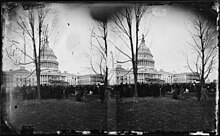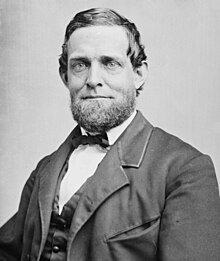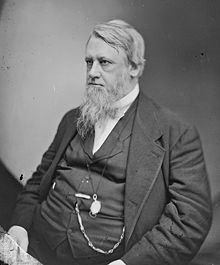42nd United States Congress
| 42nd United States Congress | |
|---|---|
41st ← → 43rd | |
 United States Capitol (1877) | |
March 4, 1871 – March 4, 1873 | |
| Members | 74 senators 243 representatives 10 non-voting delegates |
| Senate majority | Republican |
| Senate President | Schuyler Colfax |
| House majority | Republican |
| House Speaker | James G. Blaine |
| Sessions | |
| 1st: March 4, 1871 – April 20, 1871 2nd: December 4, 1871 – June 10, 1872 3rd: December 2, 1872 – March 4, 1873 | |
The Forty-second United States Congress was a meeting of the legislative branch of the United States federal government, consisting of the United States Senate and the United States House of Representatives. It met in Washington, D.C. from March 4, 1871 to March 4, 1873, during the third and fourth years of Ulysses S. Grant's presidency. The apportionment of seats in the House of Representatives was based on the Eighth Census of the United States in 1860. Both chambers had a Republican majority.
Major events
- June 10, 1871: U.S. Marines make naval attack on the Han River forts in Korea
- March 1, 1872: Yellowstone National Park was established as the world's first national park
- November 5, 1872: United States presidential election, 1872
Major legislation
- April 20, 1871: Civil Rights Act of 1871
- March 1, 1872: Yellowstone National Park founded
- May 10, 1872: General Mining Act of 1872
- May 23, 1872: Amnesty Act of 1872
- June 1, 1872: Practice Conformity Act (precursor to the Rules Enabling Act), ch. 255, 17 Stat. 196
- February 12, 1873: Coinage Act of 1873
- March 3, 1873: Timber Culture Act
- March 3, 1873: Comstock Act
Party summary
The count below identifies party affiliations at the beginning of the first session of this Congress, and includes members from vacancies and newly admitted states, when they were first seated. Changes resulting from subsequent replacements are shown below in the "Changes in membership" section.
Senate
| Party (shading shows control) |
Total | Vacant | |||
|---|---|---|---|---|---|
| Democratic (D) |
Liberal Republican (LR) | Republican (R) |
|||
| End of previous congress | 12 | 0 | 62 | 74 | 0 |
| Begin | 15 | 1 | 55 | 71 | 3 |
| End | 17 | 54 | 72 | 2 | |
| Final voting share | 23.6% | 1.4% | 75.0% | ||
| Beginning of next congress | 19 | 3 | 50 | 72 | 2 |
House of Representatives
| Affiliation | Party (Shading indicates majority caucus)
|
Total | |||||
|---|---|---|---|---|---|---|---|
| style="background-color:Template:Democratic Party (United States)/meta/color" | | style="background-color:Template:Republican Party (United States)/meta/color" | | style="background-color:Template:Republican Party (United States)/meta/color" | | style="background-color:Template:Republican Party (United States)/meta/color" | | style="background-color:Template:Other Party (United States)/meta/color" | | |||
| Democratic (D) |
Liberal Republican (LR) |
Republican (R) |
Independent Republican (IR) |
Other | Vacant | ||
| End of previous Congress | 67 | 0 | 169 | 0 | (Conservative -Virginia) 5 |
241 | 2 |
| Begin | 93 | 3 | 144 | 1 | 0 | 243 | 2 |
| End | 97 | 141 | 242 | 1 | |||
| Final voting share | 41.3% | 58.7% | 0.0% | ||||
| Beginning of the next Congress | 91 | 4 | 189 | 0 | (Independent Democratic) 6 |
290 | 2 |
Leadership

Senate
House of Representatives
- Speaker: James G. Blaine (R)
Members
This list is arranged by chamber, then by state. Senators are listed in order of seniority, and Representatives are listed by district.
Senate

Senators were elected by the state legislatures every two years, with one-third beginning new six-year terms with each Congress. Preceding the names in the list below are Senate class numbers, which indicate the cycle of their election. In this Congress, Class 1 meant their term began in the last Congress, requiring reelection in 1874; Class 2 meant their term began in this Congress, requiring reelection in 1876; and Class 3 meant their term ended in this Congress, requiring reelection in 1872.
House of Representatives

The names of members of the House of Representatives are preceded by their district numbers.
Changes in membership
The count below reflects changes from the beginning of the first session of this Congress.
Senate
- replacements: 0
- Democratic: no net change
- Republican: no net change
- deaths: 0
- resignations: 2
- contested elections: 0
- Total seats with changes: 4
Template:Ordinal US Congress Senate
|-
| Virginia (2)
| Vacant
| Legislature had failed to elect.
Previous incumbent re-elected March 15, 1871.
| John W. Johnston (D)
| March 15, 1871
|-
| Georgia (2)
| Vacant
| Foster Blodgett presented credentials as Senator-elect, but the Senate declared him not elected.
Successor elected November 14, 1871.
| nowrap style="background-color:#B0CEFF" | Thomas M. Norwood (D)
| November 14, 1871
|- | Mississippi (2) | Vacant | Delayed taking seat in order to serve as Governor of Mississippi | nowrap style="background-color:#FFB6B6" | James L. Alcorn (R) | December 1, 1871
|-
| Kentucky (3)
| nowrap style="background-color:#B0CEFF" | Garrett Davis (D)
| Died September 22, 1872.
Successor appointed September 27, 1872.
Appointee was later elected January 21, 1873, to finish the term.[1]
| style="background-color:#B0CEFF" | Willis B. Machen (D)
| September 27, 1872
|- | Louisiana (3) | nowrap style="background-color:#FFB6B6" | William P. Kellogg (R) | Resigned November 1, 1872 after being elected Governor of Louisiana | Vacant | Not filled this Congress
|- | Massachusetts (2) | nowrap style="background-color:#FFB6B6" | Henry Wilson (R) | Resigned March 3, 1873 after being elected U.S. Vice President | Vacant | Not filled this Congress
|}
House of Representatives
- replacements: 11
- Democratic: 4 seat net gain
- Republican: 4 seat net loss
- Liberal Republican: 0 net change
- deaths: 3
- resignations: 6
- contested election: 4
- Total seats with changes: 16
Template:Ordinal US Congress Rep
|- | District of Columbia At-large | New seat | style="font-size:80%" | District of Columbia's At-large district created March 4, 1871 and remained vacant until April 21, 1871 | nowrap style="background-color:#FFB6B6" | Norton P. Chipman (R) | April 21, 1871 |- | Illinois At-large | Vacant | style="font-size:80%" | Rep. John A. Logan resigned at the end of the previous congress after being elected to the US Senate | nowrap style="background-color:#FFB6B6" | John L. Beveridge (R) | November 7, 1871 |- | Michigan 4th | Vacant | style="font-size:80%" | Rep. Thomas W. Ferry resigned at the end of the previous congress after being elected to the US Senate | nowrap style="background-color:#FFB6B6" | Wilder D. Foster (R) | December 4, 1871 |- | Illinois 6th | nowrap style="background-color:#FFB6B6" | Burton C. Cook (R) | style="font-size:80%" | Resigned August 26, 1871 | nowrap style="background-color:#FFB6B6" | Henry Snapp (R) | December 4, 1871 |- | Louisiana 4th | nowrap style="background-color:#FFB6B6" | James McCleery (R) | style="font-size:80%" | Died November 5, 1871 | nowrap style="background-color:#FFB6B6" | Alexander Boarman (LR) | December 3, 1872 |- | Massachusetts 9th | nowrap style="background-color:#FFB6B6" | William B. Washburn (R) | style="font-size:80%" | Resigned December 5, 1871 after being elected Governor of Massachusetts | nowrap style="background-color:#FFB6B6" | Alvah Crocker (R) | January 2, 1872 |- | Arkansas 3rd | nowrap style="background-color:#FFB6B6" | John Edwards (LR) | style="font-size:80%" | Lost contested election February 9, 1872 | nowrap style="background-color:#FFB6B6" | Thomas Boles (R) | February 9, 1872 |- | Massachusetts 7th | nowrap style="background-color:#FFB6B6" | George M. Brooks (R) | style="font-size:80%" | Resigned May 13, 1872 after becoming judge of probate for Middlesex County | nowrap style="background-color:#FFB6B6" | Constantine C. Esty (R) | December 2, 1872 |- | Texas 3rd | nowrap style="background-color:#FFB6B6" | William T. Clark (R) | style="font-size:80%" | Lost contested election May 13, 1872 | nowrap style="background-color:#B0CEFF" | Dewitt C. Giddings (D) | December 13, 1872 |- | Ohio 1st | nowrap style="background-color:#FFB6B6" | Aaron F. Perry (R) | style="font-size:80%" | Resigned July 14, 1872 | nowrap style="background-color:#B0CEFF" | Ozro J. Dodds (D) | October 9, 1872 |- | Georgia 4th | nowrap style="background-color:#FFB6B6" | Thomas J. Speer (R) | style="font-size:80%" | Died August 18, 1872 | nowrap style="background-color:#B0CEFF" | Erasmus W. Beck (D) | December 2, 1872 |- | Connecticut 1st | nowrap style="background-color:#FFB6B6" | Julius L. Strong (R) | style="font-size:80%" | Died September 7, 1872 | nowrap style="background-color:#FFB6B6" | Joseph R. Hawley (R) | December 2, 1872 |- | Pennsylvania 13th | nowrap style="background-color:#FFB6B6" | Ulysses Mercur (R) | style="font-size:80%" | Resigned December 2, 1872 after becoming an assoc. justice of the Supreme Court of Pennsylvania | nowrap style="background-color:#FFB6B6" | Frank C. Bunnell (R) | December 24, 1872 |- | Illinois At-large | nowrap style="background-color:#FFB6B6" | John L. Beveridge (R) | style="font-size:80%" | Resigned January 4, 1873 after being elected Lieutenant Governor of Illinois | Vacant | Not filled this term |- | South Carolina 2nd | nowrap style="background-color:#FFB6B6" | Robert C. De Large (R) | style="font-size:80%" | Seat declared vacant January 24, 1873 after election was contested by Christopher C. Bowen | Vacant | Not filled this term |- | Florida At-large | nowrap style="background-color:#FFB6B6" | Josiah T. Walls (R) | style="font-size:80%" | Lost contested election January 29, 1873 | nowrap style="background-color:#B0CEFF" | Silas L. Niblack (D) | January 29, 1873 |}
Employees
Senate
- Chaplain: John P. Newman (Methodist)
- Secretary: George C. Gorham of Massachusetts
- Sergeant at Arms: John R. French
House of Representatives
- Chaplain: John G. Butler (Presbyterian)
- Clerk: Edward McPherson
- Clerk at the Speaker’s Table: John M. Barclay
- Doorkeeper: Otis S. Buxton
- Postmaster: William S. King
- Sergeant at Arms: Nehemiah G. Ordway
References
- ^ Byrd & Wolff, p. 112
- Byrd, Robert C.; Wolff, Wendy (October 1, 1993). "The Senate, 1789-1989: Historical Statistics, 1789-1992" (volume 4 Bicentennial ed.). U.S. Government Printing Office.
- Martis, Kenneth C. (1989). The Historical Atlas of Political Parties in the United States Congress. New York: Macmillan Publishing Company.
{{cite book}}: Cite has empty unknown parameter:|coauthors=(help) - Martis, Kenneth C. (1982). The Historical Atlas of United States Congressional Districts. New York: Macmillan Publishing Company.
{{cite book}}: Cite has empty unknown parameter:|coauthors=(help)
